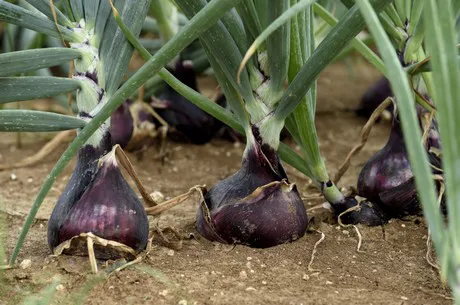The 10 largest operators of the onion sector recently came together to draw up a summary of the 2021 harvest of yellow and red onions, as an extension of the economic report from last August. Some concerns remain, but in the end, the report is more positive than what had been announced at the beginning of the campaign.

A year with a deficit in volumes and calibers
Depending on the regions, the onion harvests ended between mid-September and the beginning of October, depending on the weather conditions in late September and the maturity of the alliums.
For the yellow onions, this new campaign has a volume deficit of 12 to 20% compared to a normal year. This drop in volumes is not linked to a decrease in production areas, but to the small bulb calibers and low sanitary quality of some batches.
This year, the vast majority of the volumes have an average caliber (50/70mm) or small caliber (40/50mm). The poor weather conditions at the beginning of the summer were not favorable for the plant cycle due to the lack of sun, and they led to mildew attacks even on varieties known for their resistance. Last year, large and very large calibers were common, except in the north of France, but they will be rare in the coming months. This will cause some complications to be able to honor the processing or peeling markets for example.
Globally, the sanitary quality of the onions is good thanks to the drier and warmer weather in the second half of the summer, but questions remain regarding the poor evolution of certain batches in storage. Indeed, some have bacteriosis or fusariosis, without however reaching the proportions of the beginning of this marketing campaign.
For the red onions, the first estimates also reveal a deficit in volumes for the same reasons as for the yellow onions. A deficit in caliber is also observed with a majority of 40/60mm and very few 60/80mm. This will probably result in a shorter marketing period to the benefit of imported products. In order to avoid this perspective, the 10 operators are encouraging supermarkets to adjust their specifications for processed products so as to allow tubes or sleeves of 5 bulbs (500g) in addition to the tubes or sleeves of 4 bulbs (500g).
Excessive requirements
Despite their involvement at all stages of sorting, calibration and control at the packaging and shipping stations, the sector’s operators point out excesses of appreciation in some results of approval that seem unfounded with levels of requirements and indicators much higher than the CEE ONU standards.
In recent weeks some distributors have decided to reduce the delays of coded dates, initially between 8 and 15 days, to optimize the freshness of the alliums. As a reminder, the production of condiments comes from a single annual harvest and a “dated” contract does not necessarily have an impact on the quality of the products and their preservation.
The AGEC law, aiming to reduce plastic packaging in favor of wood cellulose, paper or cardboard, will generate very significant and concerning additional costs.
Moreover, manufacturers and distributors of bio-based packaging have already announced a probable shortage of raw materials in the near future which will create supply disruptions and generate additional price increases. With the rise in energy costs (gas, electricity) and labor, the economic balance for the operators will be strongly impacted, if the various actors do not consider in advance this extremely unfavorable context.
Are agroecological approaches truly sustainable?
The operators of the sector, including the producers, are strongly involved in the various certification approaches for the agroecological transition (Zero Pesticide Residue, No Residue Detected, Organic, Cultivated without Pesticides, High Environmental Value…). It therefore seems necessary to recall the additional costs and risks that this new dynamic of environmental progress generates. After more than 3 years of favorable weather conditions for the sanitary preservation of the plants, this year’s more humid and cooler production campaign has called into question a number of agronomic principles that seemed to be acquired and mastered. Nature has reclaimed her rights. This combination of facts has led to downgraded batches and it has impacted yields in comparison with more conventional production methods. As a consequence, the marketing prospects are down by 10 to 30% from a normal production.
The operators also recall that, besides the cultural aspects, this environmental segmentation of the offer generates crop management costs in the supply chain, fractions in storage and highly significant analysis budgets to achieve the results and liberatory phytosanitary conformities. This situation worries the producers, who are truly questioning the appeal of committing to the approach in the future.
Conclusion
The onion sector is at the crossroads of a number of disruptive elements that could weaken it over time. It should therefore be the subject of heightened vigilance. At the moment, the onion market is stable with steady prices, but an evolution is expected in February/March with prices that could rebound in view of the European and global markets.
In conclusion, the 10 largest operators of the onion sector are reminding the different actors of the need to move forward jointly towards a balanced, pragmatic and dynamic commercial relationship in order to better apprehend the technical and economic impacts of the agroecological transition and allow the onions “made in France” to still have their place on the market.
